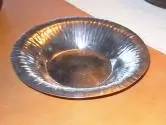Dodge Silver Extended the Close of Arts & Crafts Era

Such training led William Waldo Dodge (1895-1971) from the field of architecture into that of silversmithing and from his childhood home of Washington, DC south to Asheville, NC. Dodge opened his first silver shop in Asheville in 1924 under the name of Asheville Silvercraft. After moving to the prestigious Biltmore Forest community a few miles away, he renamed his business The Dodge Silver Shop (1927-1942).
Although he operated during an era when most people today assume the Arts & Crafts style had fallen out of favor, Dodge’s hand-hammered bowls, flatware, tea sets, platters and candlesticks remained popular until a shortage of materials forced him to close during World War II.
Collectors looking for examples of Dodge silver should note the following:
~ Dodge was fastidious about signing his pieces. Unsigned Dodge may not be.
~ Sterling silver marked “Asheville Silvercraft” was made by Dodge from 1924-1927.
~ Dodge sterling silver is noted for its heavy weight and unique hammering styles.
~ Dodge’s hollowware is far more rare than his low, flared bowls.
~ Dodge did a limited line of hammered copperware marked “Copperfield/Asheville.”
~ The majority of his pieces were commissioned by country clubs as trophies and as such were engraved. Those pieces not engraved command a premium.
While the majority of his work was originally sold in Asheville or commissioned for North Carolina country clubs, it now surfaces in all parts of the country. Some pieces traveled with tourists, others with descendents of the original owners, but the fact remains that Dodge silver can show up just about anywhere in the country.
– Bruce Johnson
Autographed copies of Bruce Johnson’s book “Hand Wrought: The Artistry of William Waldo Dodge, Silver and Architecture” are available through the author for $25, including shipping. Please direct inquiries to [email protected]

